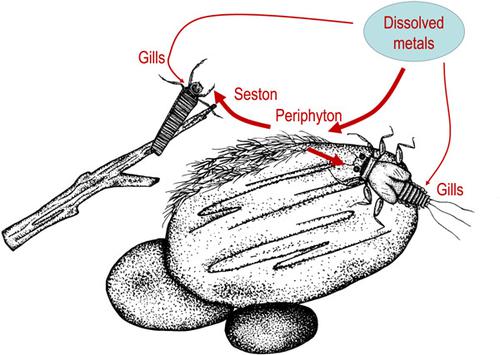当前位置:
X-MOL 学术
›
Environ. Toxicol. Chem.
›
论文详情
Our official English website, www.x-mol.net, welcomes your
feedback! (Note: you will need to create a separate account there.)
Bioaccumulation and Toxicity of Cadmium, Copper, Nickel, and Zinc and Their Mixtures to Aquatic Insect Communities.
Environmental Toxicology and Chemistry ( IF 3.6 ) Pub Date : 2020-03-26 , DOI: 10.1002/etc.4663 Christopher A Mebane 1 , Travis S Schmidt 2 , Janet L Miller 3 , Laurie S Balistrieri 4
Environmental Toxicology and Chemistry ( IF 3.6 ) Pub Date : 2020-03-26 , DOI: 10.1002/etc.4663 Christopher A Mebane 1 , Travis S Schmidt 2 , Janet L Miller 3 , Laurie S Balistrieri 4
Affiliation

|
We describe two artificial stream experiments that exposed aquatic insect communities to Zn, Cu, and Cd (year 2014) and to Zn, Cu, and Ni (year 2015). The testing strategy was to concurrently expose insect communities to single metals and mixtures. Single metals tests were repeated to evaluate reproducibility of the methods and year-to-year variability. Metals were strongly accumulated in sediments, periphyton, and insect (caddisfly) tissues, with the highest concentrations occurring in periphyton. Sensitive mayflies declined in metals treatments and effects concentrations could be predicted effectively from metals concentrations in either periphyton or in water. Most responses were similar in the replicated tests, but EC50 values for the mayfly Rhithrogena sp. varied 20-fold between the tests, emphasizing the difficulty comparing sensitivities across studies and the value of repeated testing. Relative to the single metal responses, the toxicity of the mixtures was either approximately additive or less than additive when calculated as the product of individual responses (response addition). However, even less-than-additive relative responses were sometimes greater than responses to similar concentrations tested singly. The ternary mixtures resulted in mayfly declines at concentrations that caused no declines in the concurrent single-metal tests. When updating species-sensitivity distributions (SSDs) with these results, the mayfly responses were among the most sensitive 10th percentile of available data for all 4 metals, refuting older literature placing mayflies in the insensitive portion of metals SSDs. The approach of testing translocated aquatic insect communities in 30-day artificial streams is an efficient approach to generate multiple species effects values under quasi-natural conditions that are relevant to natural streams. This article is protected by copyright. All rights reserved.
中文翻译:

镉、铜、镍和锌及其混合物对水生昆虫群落的生物富集和毒性。
我们描述了两个人工溪流实验,将水生昆虫群落暴露于锌、铜和镉(2014 年)和锌、铜和镍(2015 年)。测试策略是同时将昆虫群落暴露于单一金属和混合物。重复单一金属测试以评估方法的再现性和逐年变化。金属在沉积物、附生生物和昆虫(石蚕)组织中大量积累,其中附生生物中浓度最高。敏感蜉蝣在金属处理中数量减少,并且可以根据附生生物或水中的金属浓度有效地预测影响浓度。大多数反应在重复测试中相似,但蜉蝣Rhithrogena sp. 的 EC50 值。测试之间的差异达 20 倍,强调了比较不同研究的敏感性的困难以及重复测试的价值。相对于单一金属响应,当计算为单独响应的乘积(响应加成)时,混合物的毒性要么近似相加,要么小于相加。然而,即使是低于相加的相对响应有时也大于单独测试的类似浓度的响应。三元混合物导致蜉蝣数量下降,而在同时进行的单金属测试中,蜉蝣数量没有下降。当用这些结果更新物种敏感性分布 (SSD) 时,蜉蝣响应位于所有 4 种金属可用数据中最敏感的第 10 个百分位之一,反驳了旧文献将蜉蝣置于金属 SSD 的不敏感部分。 在 30 天的人工溪流中测试易位水生昆虫群落的方法是在与自然溪流相关的准自然条件下生成多个物种影响值的有效方法。本文受版权保护。版权所有。
更新日期:2020-04-22
中文翻译:

镉、铜、镍和锌及其混合物对水生昆虫群落的生物富集和毒性。
我们描述了两个人工溪流实验,将水生昆虫群落暴露于锌、铜和镉(2014 年)和锌、铜和镍(2015 年)。测试策略是同时将昆虫群落暴露于单一金属和混合物。重复单一金属测试以评估方法的再现性和逐年变化。金属在沉积物、附生生物和昆虫(石蚕)组织中大量积累,其中附生生物中浓度最高。敏感蜉蝣在金属处理中数量减少,并且可以根据附生生物或水中的金属浓度有效地预测影响浓度。大多数反应在重复测试中相似,但蜉蝣Rhithrogena sp. 的 EC50 值。测试之间的差异达 20 倍,强调了比较不同研究的敏感性的困难以及重复测试的价值。相对于单一金属响应,当计算为单独响应的乘积(响应加成)时,混合物的毒性要么近似相加,要么小于相加。然而,即使是低于相加的相对响应有时也大于单独测试的类似浓度的响应。三元混合物导致蜉蝣数量下降,而在同时进行的单金属测试中,蜉蝣数量没有下降。当用这些结果更新物种敏感性分布 (SSD) 时,蜉蝣响应位于所有 4 种金属可用数据中最敏感的第 10 个百分位之一,反驳了旧文献将蜉蝣置于金属 SSD 的不敏感部分。 在 30 天的人工溪流中测试易位水生昆虫群落的方法是在与自然溪流相关的准自然条件下生成多个物种影响值的有效方法。本文受版权保护。版权所有。











































 京公网安备 11010802027423号
京公网安备 11010802027423号